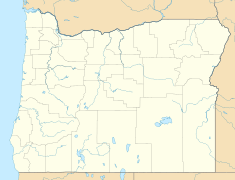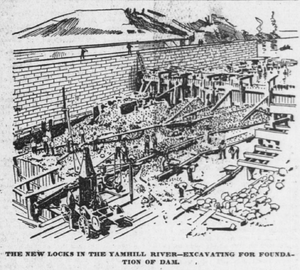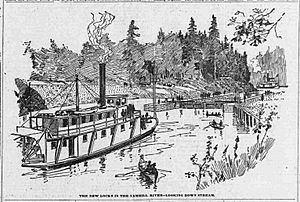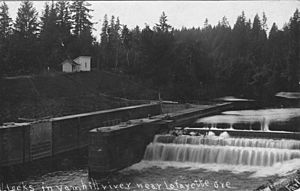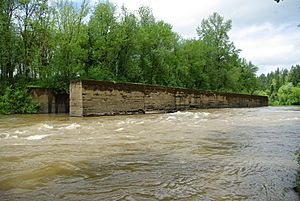Yamhill River lock and dam facts for kids
Quick facts for kids Yamhill River Lock and Dam |
|
|---|---|
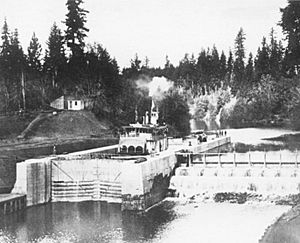
Steamer Bonita in Yamhill Lock, September 24, 1900
|
|
|
Location of Yamhill River Lock and Dam in Oregon
|
|
| Country | USA |
| Location | Lafayette, Oregon |
| Coordinates | 45°13′50″N 123°06′15″W / 45.23056°N 123.10417°W |
| Purpose | navigation |
| Status | Decommissioned |
| Construction began | 1898 |
| Opening date | September 22, 1900 |
| Demolition date | circa 1965 |
| Construction cost | $72,164.83 |
| Operator(s) | |
| Dam and spillways | |
| Type of dam | Timber-crib stone-filled |
| Impounds | Yamhill River |
| Height (foundation) | 26 feet (7.92 m) |
| Length | 125 feet (38.10 m) |
| Width (base) | 30 feet (9.14 m) |
| Spillways | one |
| Spillway type | Stepped. |
| Reservoir | |
| Maximum length | 9 miles (14 km) |
| Maximum water depth | 16 feet (4.88 m) |
|
Yamhill River Lock and Dam
|
|

Lock walls and downriver entrance, May, 2009
|
|
| Area | 8 acres (3.2 ha) |
| Architect | US Army Corps of Engineers; Normile, Fastabend & McGregor |
| NRHP reference No. | 91000799 |
| Added to NRHP | June 21, 1991 |
The Yamhill River Lock and Dam was finished in 1900. It was built near Lafayette, Oregon. Its main goal was to make river travel easier on the Yamhill River. This allowed boats to go from Dayton all the way to McMinnville, Oregon.
Even though the U.S. Army Corps of Engineers didn't think it was a good idea, the lock was built anyway. This happened mostly because local leaders really pushed for the project. For nearly 40 years before the lock was built, people had been trying to get a lock and dam constructed on the Yamhill River.
The lock was a single chamber, 210 feet (64 m) long and 40 feet (12 m) wide. It was located on the west side of the river. The dam stretched from the east bank to the lock wall. When the lock gates were closed, the dam held back the Yamhill River. This raised the water level enough for steamboats to easily reach McMinnville during the dry summer.
However, in winter, the lock and dam often caused problems. They were frequently covered by high water and floods. Sometimes the water rose more than 20 feet above the lock walls. This made them more of an obstacle than a help for boats.
The lock wasn't used much after it was built. There was a small increase in river use during the 1930s and 1940s, mainly for moving logs. The lock kept working until the 1950s. At that time, the U.S. government decided that the small amount of river traffic didn't justify the cost of keeping it open.
The lock and dam were then given to Yamhill County. The county didn't have money to keep the lock in good shape. The dam was also seen as blocking salmon from swimming upstream to lay eggs. So, it was eventually destroyed using explosives. The lock walls are still there today. The lock keeper's house, built at the same time, is also still standing. A county park is nearby where you can see the lock structure. Other parts of the original work, like old wooden posts, can be seen when the water is low.
This lock wasn't a super special engineering project. But it was one of only three lock and dam projects built by the U.S. government in Oregon and the Pacific Coast states during the 1800s. It also shows how local communities could push the national government to spend money on local projects. A big part of the project is still visible today. It's considered one of the last signs of a time when river travel was very important for moving goods and people in the Upper Willamette Valley.
The lock is sometimes called the Lafayette Lock. The Lafayette Locks Park, run by Yamhill County, Oregon, is now on the site of the old lock and dam.
Contents
- Where is the Yamhill River Lock and Dam Located?
- Early River Travel to McMinnville
- Why Was the Lock and Dam Built?
- Government Action to Build the Lock
- Building the Lock and Dam
- Opening the Locks
- How Big Was the Lock?
- Dealing with Floods After Construction
- How the Lock Was Used (1900-1902)
- Why Some People Thought the Lock Was a Waste of Money
- Problems with the Lock Design
- Later Years of Operation
- More Logs on the River
- When the Lock Stopped Working
- Giving the Lock to Yamhill County
- What Happened After the Lock Closed?
- Becoming a Historic Place
- Where to Find More Information
Where is the Yamhill River Lock and Dam Located?
The lock was, and still is, about one mile downstream from Lafayette. It's also about five miles upstream from where the Yamhill River meets the Willamette River. The Yamhill River dropped about 13 feet (4.0 m) between McMinnville and the lock. In its natural state, the river had rapids from Lafayette (originally called Yamhill Falls) down to the lock site. The river dropped nine feet over these rapids.
The Yamhill River starts in the Oregon Coast Range. It flows east for about 45 miles (72 km). Then, it joins the Willamette River about 40 miles (64 km) upstream from Portland, Oregon. Small steamboats regularly traveled to Dayton, which is about five miles from the Yamhill River's mouth. Lafayette was about 8 miles (13 km) upstream from the river's mouth.
At Lafayette, the river dropped 8.8 feet (2.7 m) over 1 mile (1.6 km) of rapids. From the end of the rapids to the river's mouth, the drop was only 1 foot (0.30 m). High water in the Yamhill River, or a 10 feet (3.0 m) rise in the Willamette River, would cover these rapids.
From Lafayette, the river ran about 9 miles (14 km) to McMinnville. McMinnville was the main town of Yamhill County, Oregon, a rich farming area. This part of the river was 40 to 100 feet (12 to 30 m) wide. It was blocked by snags (tree trunks stuck in the river) and trees hanging over the water. The snags were especially bad for about 3 miles (4.8 km) downstream from McMinnville. If these obstacles were removed, steamboats drawing 2.5 to 3.0 feet (0.76 to 0.91 m) of water could reach McMinnville. Boats could only pass over the rapids for about five months a year.
In 1892, there were no preparations for using the river to ship products. No roads led to the river, and there were no storage buildings on the banks. People didn't seem very interested in the recent river clearing. One steamboat regularly traveled all year between Portland and Dayton and did good business. This boat could have gone to McMinnville if there had been enough business.
In 1892, a train line crossed the Yamhill River at McMinnville and Lafayette. These towns were only 5 miles (8.0 km) apart by wagon road. Lafayette and Dayton were only 2 miles (3.2 km) apart by road, and the land was flat.
In 1910, the Yamhill River was described as "a clear stream of shallow and deep parts in Summer, a rushing river in Winter." In 1874, the U.S. Army's engineering team studied the Yamhill. They found that the river could change from shallow pools in summer to a "river of great power and strength" in winter and spring floods. Its waterlines on the banks sometimes showed a rise of over 60 feet (18 m).
Early River Travel to McMinnville
Before the lock was built, small steamboats could reach McMinnville. Very early steamers like the Enterprise (115 ft.) and Hoosier (50 ft; 5 tons) traveled upstream from a place called Martin's Landing. This was where the dam was later built. The steamer Elk, 60 short tons (54 t), also ran on the Yamhill in the late 1850s. However, after one season, it was found to be too big for the route.
In 1867, the People's Transportation Company offered freight service to McMinnville for $7.00 per ton. In 1871, the Willamette Transportation Company offered steamer service to McMinnville for $3.00 per ton from Portland.
In March 1895, the steamer Toledo (128 ft; 226 tons) made regular trips to McMinnville. Toledo was likely the first steamer to reach McMinnville in 14 years. In November 1896, the steamer Gypsy (101 ft.; 213 tons) was temporarily put on the Portland-McMinnville route.
Why Was the Lock and Dam Built?
Even before Oregon became a state, there were five local attempts to build a lock or locks on the Yamhill River. In 1858, the Oregon Argus newspaper urged Yamhill County to build a lock at the river's mouth. This would allow boats to travel on the river all year. The State Rights Democrat newspaper blamed the failure to build the locks on one political party.
On January 17, 1859, before Oregon officially became a state, Christopher E. Switzer, who owned the steamer Elk, started a company. It was called the Yamhill Water-Lock and Dam Company. With $50,000, it planned to build a lock at the Yamhill's mouth. This lock would be big enough for a 60 short tons (54 t) vessel, the same size as the Elk.
On December 27, 1869, the Yamhill Locks and Transportation Company was formed. This company had $75,000. Its main office was in McMinnville. Its goal was to build locks at the Yamhill's mouth and at the rapids in Lafayette. A dam was built at the Yamhill's mouth, but a flood in November 1871 washed it away.
Other companies were also formed to build locks. None of these companies were able to build, or even start to build, a lock on the river.
Government Action to Build the Lock
State and Federal Laws
In 1876, the Oregon state legislature passed a law. It allowed a company to build locks on the Yamhill River at Lafayette. The state kept the right to buy these improvements later.
On July 13, 1892, a U.S. federal law called the Rivers and Harbors Act was passed. It asked the Corps of Engineers to study if it was possible to make the Yamhill River easier to navigate. This would involve building a lock and dam at Lafayette. The same law also allowed $3,000 to be spent to remove snags and overhanging trees between Lafayette and McMinnville. This clearing work was done in October and November 1892.
In early December 1892, Major Thomas H. Handbury of the Corps of Engineers traveled the river in a small boat. He found it in "very good boating" condition. The river was about 12 feet (3.7 m) above its low water level. At this level, the rapids at Lafayette were completely covered.
Major Handbury concluded that building a lock and dam at Lafayette was not important enough for the federal government to pay for. He felt there were already enough roads, train lines, and river transport options. His bosses at the War Department agreed and told Congress not to fund the project.
However, on May 13, 1896, a new Rivers and Harbors bill passed in the U.S. Senate. It allowed $200,000 for river improvements, including the Yamhill River lock. But only $40,000 was actually set aside at first. Congressman Thomas H. Tongue helped get this money for the project.
The War Department still didn't want to build the lock. But U.S. Representative Binger Hermann strongly supported it. He claimed that more river traffic on the Yamhill would pay for the whole project within a year. Other politicians also pushed for the lock and dam. Harvey W. Scott, the editor of Oregon's biggest newspaper, The Oregonian, also supported the project.
In November 1897, U.S. Senator George W. McBride sent a telegram saying the lock would be built. He said Congress would provide the money. Also in November 1897, Brigadier General John M. Wilson told Yamhill County leaders that Congress had set aside another $160,000. This meant there was enough money to build the lock and dam.
Building the Lock and Dam
Getting Started
On January 3, 1898, Captain W.L. Fisk of the U.S. Engineers asked companies to bid on building the dam and other structures. Bids were due by February 10, 1898. On February 11, six bids were received. The lowest, for $59,918, came from a partnership in Astoria, Oregon. This group was Simon Normile, John Anton Fastabend, and William F. McGregor. They won the contract on March 11, 1898.
The contract said the project had to be finished by December 31, 1898. The government hadn't bought the land yet. So, work couldn't start until the government owned the land. After that, construction had to begin within 10 days. Some parts, like the lock keeper's house, had to be done within 60 days.
The Normile company expected to start work about two weeks after getting the contract. Most of the construction would use concrete. The stone for the concrete would come from within 2 miles (3.2 km) of the site. Building materials, including 500,000 board feet of lumber and about 60,000 pounds (27,000 kg) of iron, would be shipped from Astoria.
Construction Begins
On April 8, 1898, the government bought the land for $275. On June 14, 1898, the builders were told to start. Some work on the keeper's house had already begun on May 12. The area was originally known as Martin's Landing.
Other work, like gathering materials and hiring workers, had also started. On April 20, 1898, the builders arrived in Lafayette. They began setting up to start work. Workers would immediately build a boarding house and a flat-bottomed boat called a scow. The project site was covered with thick trees and needed to be cleared. After that, rock and timber would be brought to the site. This early work was expected to take two to three weeks.
The Spanish–American War, which started on April 21, 1898, caused prices for workers and materials to go up. The deadline for finishing the project was extended twice. First to November 1, 1899, and then to October 1, 1900. This was because the contractors had trouble finishing the work.
By June 20, 1898, fifty men and teams were working. The contractor hoped to finish before the fall high water. By July 21, only twenty men were working. The contractor hoped to finish by the fall rains.
On August 9, 1898, the concrete contractor, John Crawford, said work would speed up. A 40-horsepower boiler and steam engine would be used for the concrete mixer. Two work teams would be used, one by day and one by night. They also planned to install electric lights. Crawford said it would take about 60 days to finish.
By November 18, 1898, the inner concrete wall was done, and work on the outer wall had started. Work was moving fast to finish before winter. Work on the locks stopped on November 30, 1898, because of high water.
On October 3, 1899, the lock gates were installed and adjusted. The valves were in place, and the miter sills (under the lock gates) were fitted. Wooden posts were driven into the ground for the dam and to protect the riverbank. The river was sent through the lock so the main dam could be finished.
On October 6, 1899, it was reported that the temporary dam (called a cofferdam) at the site had washed out a second time. This might delay the project.
Steamboats were still using the river during construction. On November 13, 1899, the steamer Gypsy passed the lock at noon. Returning after dark, it hit the lock and dam, causing damage.
The lock was supposed to be finished in 1899. But five high water events on the Yamhill River prevented this. The river stayed high longer than usual. When the fall rains came, the cofferdam washed away. Work had to stop until the water was lower and the weather was better in 1900.
Finishing the Project
By July 1, 1900, the lock walls, gates, and other equipment were complete. The timber protections and grading on the west side of the river were three-quarters done. The main dam was one-third complete. Work hadn't started on the main dam's crib section or the protections on the east side.
On August 1, 1900, temporary dams were finished above and below the main dam. The river's entire flow was sent through the lock chamber. After that, work began on the dam's foundation. The entire dam was finished on September 1, 1900.
On September 15, 1900, the lock chamber was closed. The river began to back up behind the dam. Four days later, on September 19, water started spilling over the dam.
Opening the Locks
On September 21, 1900, the lock was working perfectly. It filled in six and a half minutes and emptied in three and a half. The total cost to build it was $72,164.83. That day, Captain Wm C. Langfitt inspected and informally opened the lock.
At 1:00 p.m., a government steam launch, with Captain Langfitt driving, entered the lock. Ten minutes later, the launch was raised to the upper river level. It then headed towards McMinnville, which was 10 miles (16 km) away by river. The launch reached McMinnville just before the train to Portland. After greeting local citizens, Captain Langfitt took the train back to Portland.
Assistant Engineer D.B. Ogden returned to the lock to prepare it for the official handover to the government. This happened on October 1, 1900. All work during the 1901 fiscal year was overseen by engineer Ogden.
All the work was considered complete on September 22, 1900. The government officially accepted the works. They were formally opened to boats two days later, on September 24. The Morning Oregonian newspaper praised the completion. It said that from then on, "boats will run the year round between Portland and McMinnville."
How Big Was the Lock?
The lock was 275 feet (84 m) long overall. The distance between its gates was 210 feet (64 m). The lock was 40 feet (12 m) wide. There was 4 feet (1.2 m) of water depth over the lock's bottom sills. This meant any boat that could pass the Willamette Falls Locks could also use the new Yamhill lock.
The land wall was 12 feet (3.7 m) thick at its base and 8 feet (2.4 m) thick at the top. The river wall was 12 feet (3.7 m) thick from top to bottom. The lower lock gates were 25 by 25 feet (7.6 by 7.6 m), and each weighed 15 short tons (14 t). The upper gates measured 9 by 25 feet (2.7 by 7.6 m) and weighed 9 short tons (8.2 t) each.
There were no valves in the upper gates. The lock chamber was filled by culverts (tunnels) in the lock walls. These culverts were 3 by 6 feet (0.91 by 1.83 m). They were opened and closed by vertical butterfly valves. The lower gates had horizontal butterfly valves, 2 by 4 feet (0.61 by 1.22 m) in size, used for emptying the lock chamber.
The lock floor and walls rested on a concrete foundation four feet thick. The walls rose 26 feet (7.9 m) above it. The lock floor was also 4 feet (1.2 m) thick. The deeper foundation had a timber frame on 700 round piles, driven 30 to 50 feet (9.1 to 15.2 m) deep. About 8000 cubic yards of concrete were used. The lock could lift boats 16 feet (4.9 m).
The dam holding back the Yamhill River was 125 feet (38 m) long and 30 feet (9.1 m) wide at its base. The dam rose in steps. It was built from 100,000 board feet of timber and 1400 cubic yards of rock.
The lock keeper's office was on the west side of the river, on a hill above the high water mark. The highest water level recorded before the lock was finished was 34.5 feet (10.5 m). This would have been 13.5 feet (4.1 m) over the lock walls. The lock keeper's house was on the east side, also above the high water mark. A folding iron bridge allowed crossing the lock at normal water levels.
Dealing with Floods After Construction
From November 1900 to April 1901, there were ten high water events on the Yamhill River. The river banks near the lock and dam were not as strong as planned. River conditions were also worse than expected. After a December flood, a 40 feet (12 m) section of protected bank fell into the river. The dam was also in danger of being washed away. Workers put 150 square yards (130 m2) of rock in front of the dam to protect it.
A third flood in December 1900 covered the lock walls by 10 feet (3.0 m). It also dug out a channel about 25 feet (7.6 m) wide and 9 feet (2.7 m) deep along the land side of the west lock wall. This area had been finished too late in the season to be protected with grass.
From January 12 to 19, 1901, the Yamhill River had its highest rise since 1894. The water was 25 feet (7.6 m) over the lock walls. If only the Yamhill had flooded, there would have been terrible damage. But because the Willamette River also flooded, the current in the Yamhill slowed down.
More damage happened from a flood in February, which sent water 11 feet (3.4 m) over the lock walls. Other floods in March and April also covered the lock walls, but not as high.
During the low water season of 1901, the Corps of Engineers planned to spend $26,160. This money would extend a concrete wall, fix slopes, replace rock protection, and add more stone to the dam's base. In early July 1901, the Corps of Engineers had 50 men working. They were shaping and laying stone on the banks above the lock to protect them from erosion during floods. This work was finished by November 1901.
About 50,000 square feet (4,600 m2) of the slopes were paved with rock. The dam was extended 25 feet (7.6 m) further onto the east bank. The slopes above the rock protection were made less steep and planted with grass. This was thought to be enough to handle future floods. Construction continued while boats used the locks. By December 6, 1901, the work on the locks was finally complete and ready for winter.
How the Lock Was Used (1900-1902)
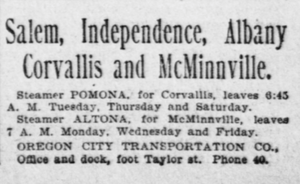
On September 24, 1900, the steamer Bonita (later called Metlako) was the first steamboat to use the lock. From its opening on September 24, 1900, to June 30, 1901, the lock was open for 202 days. It was closed for 78 days due to high water. There were 225 times boats passed through the lock. Total operating time was 67 hours and 32 minutes. Boats carrying 38,967 tons passed through. They carried 1,742 tons of freight and 2,010 passengers.
In November 1901, steamboats were regularly traveling between Portland and McMinnville. They went upstream one day and downstream the next, full of grain. One steamboat, the Altona, made three trips a week from Portland to McMinnville in November 1901.
On January 6, 1902, the Oregon City Transportation Company advertised regular service on the steamer Altona from Portland to McMinnville. Altona was set to leave Portland for McMinnville at 7:00 a.m. every Monday, Wednesday, and Friday.
On January 8, 1902, the Yamhill River water rose too high for boats. The steamer Altona, which had just started its route again, could only go as far as Dayton.
Altona's previous stop in service was due to a lack of business. With no steamboat service, merchants in Dayton and McMinnville thought about building their own steamer. Captain Graham, who owned Altona, talked with the merchants. They agreed to provide enough business, and Captain Graham agreed to keep Altona on the McMinnville route.
During the 1902 fiscal year, boats passed through the locks 246 times. They carried 48,240 tons of vessels and 3,455 tons of freight. This included 571 tons of sand and gravel for lock repairs. Railroads lowered their prices to compete and kept most of the shipping business.
In 1902, despite the merchants' agreement, the Oregon City Transportation Company stopped its steamboats from going above Dayton for good. The company said it was too hard to know when the lock would be open in winter. This made it impossible to build up business. Even though efforts were made later, this marked the end of regular commercial steamboat use of the lock. This happened just two years after the lock was built to help establish that service.
Why Some People Thought the Lock Was a Waste of Money
Yamhill locks were constructed, advocated the construction of an electric line from that city to Dayton, and predicted that the locks would give no relief In traffic to the people of McMlnnvllle. Which has proved correct. Not that the government engineers under whose supervision the locks were constructed did not do good work; we heard those say, who ought to know, that the work was first class. Now, gentlemen, while you are waiting for that boat to run up to your city, and the S. P. Co. to build that extension from LaFayette to our city, "got In' with your sleeves rolled up. and assist In building an electric line from your city to Newberg, via LaFayette and Dayton to Salem. It will pay.
Salem, Oregon
June 25, 1903
In late May 1903, the government had workers at the locks. They were grading, planting grass, and making other improvements. By this time, it was clear that the lock wasn't being used much. The editor of the Hillsboro Independent newspaper commented, "But you wanted the locks, did you not?"
In June 1903, the Hillsboro Independent reported talk of closing the locks because there wasn't enough river traffic. The newspaper sarcastically said, "The improvement seems not to have revolutionized the transportation of freight out of Yamhill county." Another newspaper, The Daily Journal from Salem, also criticized the decision to build the locks, calling them useless.
In June 1903, a raft of ash logs, about 900 feet long, passed through the Yamhill locks. It was going to a sawmill. Steamboat operators said only one steamer had used the locks that year. The Oregon City Courier newspaper said the locks were "useless to navigation." They also said that at high water, the locks flooded and became an obstruction. There was almost no boat traffic on the Yamhill River above Dayton. The newspaper felt the $93,000 spent by the government was wasted. They said people preferred the railroad to the winding Yamhill River.
In October 1910, The Morning Oregonian, which had once supported the project, criticized the lock and dam. It said the project had not made the Yamhill River navigable.
Problems with the Lock Design
After 1902, official reports from the Corps of Engineers always said that no commercial steamboats were regularly using the lock. Steamboats had "practically abandoned" the lock after 1902. From 1902 to 1914, the locks were mostly used by people in small boats and by boats pulling rafts.
A big problem with the lock and dam was that the lock had to be closed during high water. This was because the river simply flowed over the lock walls, making the lock unusable. On the Willamette River, high water (usually in fall and spring) was the best time for steamboats. Late summer and early fall were the worst, with low water levels. On the Yamhill above Lafayette, the dam created the opposite situation.
The original design of the lock assumed that steamboats could just float over the dam when the water level rose 5 feet above it. But in reality, this was impossible. Until the water rose 12 feet (3.7 m) above the dam, the drop between the upper and lower water levels was too big for a steamboat to pass safely.
In 1903, several ideas were suggested to fix this problem. But they were all rejected because they were either not practical or too expensive.
Later Years of Operation
1903 to 1910
On December 31, 1902, heavy rains caused the Yamhill River to rise very quickly. By that date, the water was 5 feet (1.5 m) over the lock walls. In late January 1903, the Willamette River flooded. This backed water up to the locks, where the water reached 42 feet (13 m) on the gauge. On January 26, 1903, the Yamhill River was pouring 21 feet (6.4 m) deep over the lock walls and was still rising. The lock was closed to boats by high water on November 20, 1904. The highest water recorded in the 1905 fiscal year was on December 31, 1904. The river rose 11.1 feet (3.4 m) above the lock walls. No damage happened to the lock, dam, or nearby slopes.
From November 20, 1904, to April 2, 1905, the lock was closed for 46 days and open for 86 days. From April 2, 1904, to June 30, 1905, the lock was open continuously. Total spending on maintenance, labor, and materials for the 1905 fiscal year was $1,274.13. There were 123 lockages. Most were for towboats, wood barges, log rafts, fishing boats, and small launches. Total operating time was 74 hours and 12 minutes.
In three months of the 1905 fiscal year (July 1904, September 1904, and May 1905), there were only two lockages each month, even though the lock was open all month. Total freight passing through the lock in 1905 was 4,109 tons. Total passengers were 44. Except for 17 tons of sand, almost all the freight was logs or wood for paper pulp. In November 1906, the locks were again closed due to a flood. Water was flowing over the lock walls.
On August 31, 1908, the steamer Leona started a three-times-a-week trip from Portland to McMinnville. This was the first time in about five years that a steamboat had operated above the lock. It reportedly carried a good amount of cargo on its first trip. A few days before, Leona had been brought up to McMinnville. This scouting trip was hard because of snags and floating logs in the river. The government boat that removes snags was expected to clear these obstacles soon.
In mid-September 1908, the water behind the dam was lowered. This was to allow a fish ladder to be built around it. As a result, the river "scarcely floats a plank." So, Leona had to stop its trips to McMinnville. By the end of 1908, a fish ladder had been installed at the dam.
During the 1909 fiscal year, the locks were used 155 times. The locks were closed for 74 days, from September 23, 1908, to March 24, 1909, because of high water. The cost to operate the locks in 1909 was $1,188.66.
1911 to 1920
It was a pleasant lock where the tender could grow gray in solitude, undisturbed in his meditations, because only an occasional steamboat came along to wake him up. At the beginning there was practically no traffic on the Yamhill, and what there was steadily declined until, in 1921, only lone ton of freight went through the locks, traveling in solitary grandeur. In addition, about 2,100 tons of rafted logs went down the river, along with 26 passengers that year.
During the 1913 fiscal year, the locks were used 91 times and closed for 65 days due to high water. The cost to maintain the locks in 1913 was $1,300.28.
In 1914, the Oregon City Transportation Company had regular steamboat service on the Yamhill River, but only as far as Dayton. From 1913 to 1915, the following amounts of freight (in short tons) moved through the locks: 1913, 432 tons; 1914, 1,314¼ tons; 1915, 639 tons.
In April 1914, it was reported that a steamboat would use the locks again. It would move paving material from Portland to McMinnville. Measurements were taken of three bridges crossing the Yamhill. It was found that there was enough space under them for a steamboat to pass.
In its 1916 report, the Corps of Engineers wrote, "there is no regular boat traffic through the lock." On December 5, 1916, rising waters in the Yamhill River covered the lock. This blocked boats from reaching McMinnville. The steamer Woodland returned to Portland on December 5, 1916, after failing to go beyond Dayton. The steamer Pomona was scheduled to leave Portland for Dayton on December 6, 1916, but no further upriver.
In February 1917, Carl M. Johnson, mate of the government snag boat Mathloma, was made lock master.
New lock gates were installed in the summer of 1919. The original gates had not been replaced since the locks opened. Work began on July 11, 1919. The new gates were built at Oregon City. The original gates were made of Douglas fir. On August 10, 1919, work on the replacement gates was finished.
In July 1924, the Greyhound Transportation Company suggested putting a small steamer on the Yamhill River. If there was enough business, it would use the lock to serve McMinnville. This steamer would be only about 65 feet (20 m) long. This was small enough that it would only need a crew of two men. With fewer crew members, it could save money and be more likely to make a profit.
1921 to 1930
As of July 5, 1925, a year had passed since a boat had used the locks. The gates had to be opened once a week to make sure the machinery was in good condition. There wasn't much else for the lock keeper to do except mow the lawn and water plants at the small park the government had made at the locks.
More Logs on the River
In the 1930s, a series of forest fires, known as the Tillamook Burn, greatly increased the number of salvaged logs shipped down the Yamhill River through the lock. An important railroad trestle also burned. This left the river as the best way to transport logs. In 1939, the number of logs transported on the Yamhill River was over 200 times greater than in 1931.
The lock was closed from May 25 to June 20, 1935. During this time, new lock gates were installed, and repairs were made.
In 1941, 99,000 tons of logs, along with small tugboats, passed through the lock. In 1943, 101,981 tons of logs came through the locks. This was the highest amount ever. It dropped to 79,895 tons in 1946. In March 1947, the large Pope and Talbot logging company bought land upstream from the locks. They set up a place to dump logs. Trucks brought logs to the river, where they collected behind the dam, and dumped them into the water. Tugboats came through the lock and towed the logs downstream. This continued until the early 1950s. Then, the log dump was destroyed by fire and rebuilt at Dayton, downstream from the lock.
On September 8, 1949, the water behind the lock and dam was lowered to 2.5 feet (0.76 m). This was to allow repairs to be made to the dam and fish ladder.
When the Lock Stopped Working
From 1944 to 1953, the amount of goods passing through the lock dropped from 119,006 tons to 32,986 tons. Most of this was log rafts for just one company. In July 1953, the Army Corps of Engineers removed the local lock master. They decided to open the locks only if they received 24 hours' notice from the lock master at Willamette Falls Locks in West Linn, Oregon.
In July 1953, the lock and dam needed about $95,000 worth of repairs. But the operating budget had been cut from $10,000 to $5,000. There wasn't enough boat traffic to justify the repair cost. However, local farmers used the water behind the dam for irrigation. People also used the waterway for pleasure boating.
The Corps of Engineers also planned to close the seven-acre park. This upset the people of Yamhill County. The Corps felt it couldn't maintain a park unless it was connected to a navigation project. For a small amount of money, the Corps of Engineers was willing to lease the lock, dam, and park. The Yamhill County government didn't even have the money to maintain the park. So, an effort was made to get the state to take it into the state park system.
In 1954, the lock stopped working permanently. This happened when logging companies said they would no longer use the lock. All commercial boat service through the lock had stopped many years before. After the lock was shut down, a large log floating down the river went over the top of the lock. It hit the lock machinery, making the lock permanently unusable.
Giving the Lock to Yamhill County
In 1956, a bill was passed by Congress. It allowed the lock and dam to be given to Yamhill County. This bill, supported by U.S. Representative A. Walter Norblad, allowed 28 federal locks and dams that were no longer in use to be transferred. President Dwight D. Eisenhower signed the bill in early August 1956. The bill allowed the Corps to give the property to state, county, or other groups.
The state park superintendent, C.H. Armstrong, said the park would go to the county. Yamhill County Commissioner Charles R. Newman said the county was only interested in the eight-acre park, not the lock. He said a park commission was set up to manage it. Newman also said that farmers were interested in the dam for irrigation.
The last boats to use the lock were five pleasure boats. They had come up the Willamette and Yamhill rivers specifically to use the lock on its closing day.
What Happened After the Lock Closed?
The Corps of Engineers had kept the land next to the lock and dam as a park for many years. The county had wanted the property for a long time. The river there had become a popular place for swimming.
The transfer finally happened on January 19, 1959. The property, including the park area, was given to Yamhill County. The details of the transfer were handled by the General Services Administration.
In June 1960, the Oregon State Fish Commission ordered Yamhill County to either build a fish ladder at the dam or remove the dam completely. By this time, the lock gates had broken. But the dam still held water for about 20 farmers. After three years of talks and arguments, the dam was destroyed with explosives on September 18, 1963. This was ordered by the state fish commission to help salmon swim upstream.
Becoming a Historic Place
On June 21, 1991, the lock and dam were added to the National Register of Historic Places. At that time, much of the original structure was still there. The lock walls were the most noticeable parts. About halfway along the east side of the water wall, there's a pile of stones where the dam once stood. Water falls about 6 feet (1.8 m) over these stones. When the water is low, old wooden posts and parts of the wooden riverbank protections can be seen. Parts of the lock gates still lay on the lock floor. The original concrete walkway along the top of the east bank was also still there. It offered a good view of the lock. The lock keeper's house, on the east side of the river, still existed in 1991. However, it was not included in the historic listing because it was privately owned.
A county park and picnic area had been set up on the grounds and was being used in 1991. This did not take away from the historical importance of the location.
Where to Find More Information
Plans and drawings for the lock, made by the Corps of Engineers, are now kept at the Oregon Historical Society.


